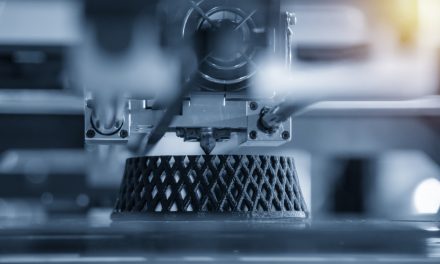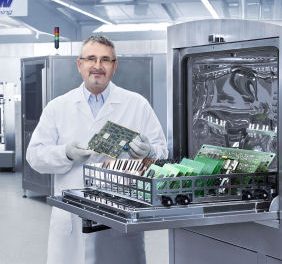Three Problems and Solutions – Using Data Analytics to Improve Production Line Flow

By Jonathan Simard, Product Manager – Analytics & Traceability, Cogiscan
It is one thing to know how your PCB assembly lines are doing in the moment, but it’s another thing entirely to be able to see and understand production trends before ending up with a major problem. Through historical data analytics, you can identify where to improve in order to design and manage a better production flow.
In this short article, we’ll cover three concrete examples that show how historical analysis, or data analytics, is a great tool for anyone who wants to have better results in the PCB assembly factory.
Problem #1: Decrease in Production Yield
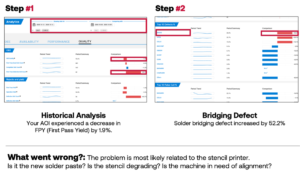
For example, let’s say you ran two orders of the same product on the same PCB assembly line and, while looking at your historical data analytics, you realize that you had a decrease in first pass yield (FPY) of 1.9% from one week to another. It may not seem a lot but if you look at the First Pass Defective Unit Count, you realize an increase of 42.9%! Red flag – why did this happen? Since it could be a myriad of variables, a great way to narrow it down quickly is to analyze your Top 10 Defects. In this specific case, your AOI had an increase of 52.2% in bridging defects and is your biggest defect.
While this does not tell you exactly what your problem is, it is still a very helpful starting point to guide your investigation. In this case, the PCB assembly factory had recently changed its solder paste – causing more bridging defects caught at AOI. Naturally, to avoid heavy rework costs, this manufacturing company chose to return to their previous solder paste supplier. Time and materials are valuable, especially lately…
Other potential problems: Stencil condition, machine alignment, etc.
Problem #2: Increase in Assists
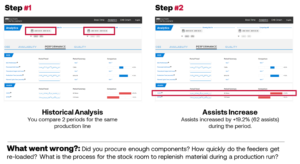
In this other example, our PCB assembly factory used data analytics to run a comparison report for the complete line to analyze performance for March and April. While most of the KPIs were good, one of them stood out as a poor result. Assists increased by 19.2% (62 assists) in April. Yikes! A big concern for any PCB assembly factory.
The good news is that, through historical data analytics, you’re now aware of this problem. In this specific case, the data revealed that the high-speed placement machine was frequently down to empty feeder issues – the machine was idle for several minutes before the feeders were replenished and production could resume. This scenario highlights one of the many impacts of the current supply chain shortages. Staff in the stockroom were forced to split reels before sending them to the floor, thus adding to the line’s replenishment cycle time.
This situation also prompted this PCB assembly factory to install monitors in the stock area to display low-level warnings from the SMT line in real time with alerts on which reels will be needed at the line and when. This stockroom team now relies on this information to be fully prepared, and to supply required reels to the line just in time before the line stops due to empty feeders. In fact, the line productivity has since increased by more than 5% due to less idle time waiting for components!
Problem #3: Pick & Place Performance Issue
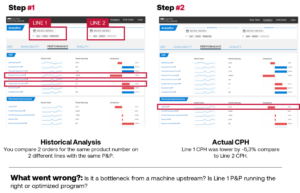
It’s not always feasible to run a product on the same PCB assembly line all the time. Typically, PCBA manufacturers program and qualify a product on every SMT line possible – that way you’re able to run product no matter what line comes available.
In this specific example, the production manager noticed that PRODUCT_PN2 was experiencing very different production & cycle times depending on if it was assembled on Line 1 or Line 2. Using a data analytics dashboard, the SMT manager started off by looking at the biggest operation during the SMT process – he compared the performance of the placement machines on the two lines.
While very similar machines – same brand and model – he was seeing very different cycle times for those two lines. Could it be a bottleneck from a machine upstream? Or perhaps the placement machine from Line 1 never updated the latest optimized program. Upon deeper inspection, sure enough placement machine from Line 1 was using an older and less than optimal program.
Conclusion
While these are very simple examples, they provide an understanding on how your PCB assembly factory could benefit from a historical data analytics web tool. If you’re already experiencing a specific problem, and you’d like to discuss how to solve it with a tool like this, please contact us.



